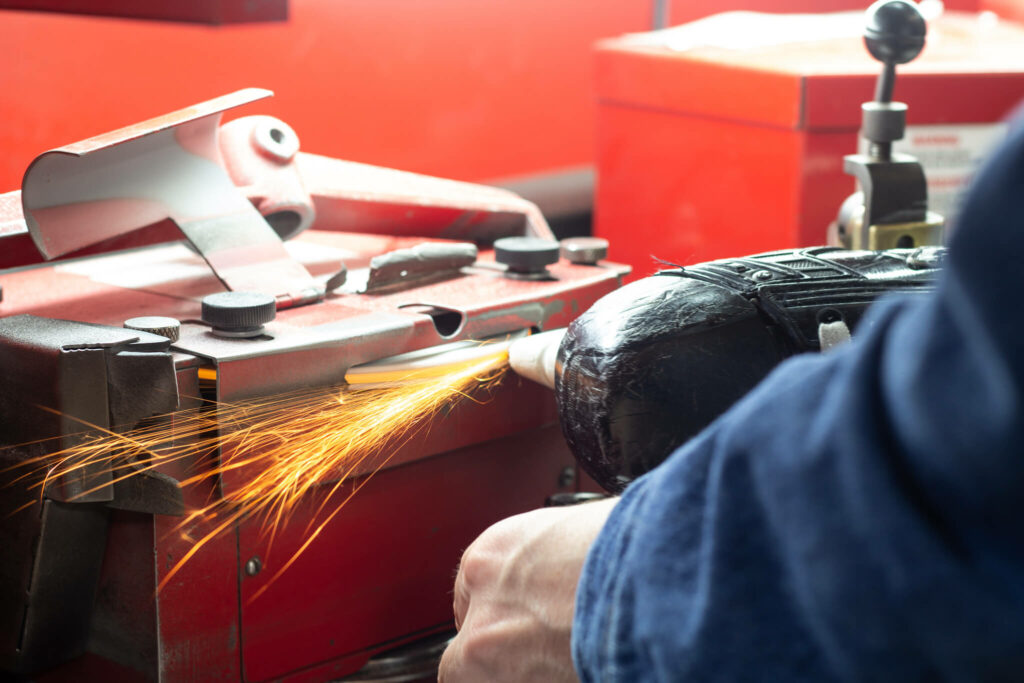
DON’T BE A “BENDER” SHARPEN YOUR SKATES MATE! – ALL THE NEED TO KNOW TIPS AND TRICKS AROUND GETTING YOUR SKATES SHARPENED.
Skating really is one of the finer things in life. Nothing beats the sweet sound of the steel of the blades cutting through the ice as you zoom across the rink. Bliss. That is until you go for the turn but instead, blow your tires and are left feeling powerless as you spin into the boards. That feeling of bliss: gone. Blunt blades are one of few things that are a skater’s kryptonite – that and a swapper bottle of your teammates’ nasty homebrew. So how can you avoid this absolutely gut-wrenching situation? No need to worry because we have some tips for you.

A good rule to follow is to have your skates sharpened every 5-10 hours of skating time, some prefer to have their skates more frequently, others less often. It really depends on how aggressively you skate. For a player who goes all out and has advanced skills, 3-4 hours or 2 games and a practice is an ideal amount of time to wait between sharpens. An intermediate levelled skater would be better suited to sharpen their skates after every 5-6 hours of skating, or 4-6 games or practices. It is harder to comment on a beginner skater as they are still figuring out how aggressive they are as a skater, so the frequency of their sharpens would decrease to sharpening after 10 hours of skating. If you are just learning how to skate, it is much easier to do so with freshly sharpened blades – nothing is as more frustrating as trying to learn a new skill with equipment that isn’t up to par. A player will typically lose between 15%-25% of their edge efficiency every hour that they spend on the ice. Even though the hollow (type of sharpening you get on the blade) remains the same while you skate, the edges of the blade will wear.
Unsure about whether you need a sharpen or not? Ask your coach! They watch you the most and are aware of your skating technique, or, come into our store and ask one of our staff members!
It is worth noting that colder ice, especially the type found outdoors, is much harder and will dull your skates very quickly. If you’re playing with your buddies on an outdoor rink, it’s probably a good idea to get a sharpening before your next game.
HOW SHARP TO GET YOUR SKATES?
Looking at the bottom of your hockey skates, you’ll notice that the blade doesn’t look or feel like a knife or any ‘normal’ blade. This is because a skate blade has two sharp edges with the middle hollowed out. The hollow can be deeper or sharper, depending on your preference.
These hollows are measured in fractions of an inch (fractions, disgusting I know) from 1″ to 3/8″ or 1/4″. The actual process of sharpening skates involves passing the skate blade over a spinning stone with a rounded outer surface. The surface can be modified to have a very curved surface, or a flatter surface. Altering the shape of the wheel’s surface will alter the size of the hollow it creates on the blade. A larger radius means a flatter grinding wheel, therefore the skate will have less hollow cut away from its centre. The normal range for this is ⅜” to ¾”, although higher or lower hollows are occasionally seen.
Here at Centre Ice, we typically do a ½” hollow as a default as this best suits the ice conditions generally in New Zealand.
In the pictures here, you can see what these hollows look like when viewed up close

HOW HOLLOWS AFFECT YOUR GAME
SMALLER RADIUS OF HOLLOW (I.E. ⅜” – DEEP HOLLOW)
- More Bite
- Better suited to lighter players who dig in less to start with
- More drag ( with more blade sitting in the ice)
- Extra effort required to skate
- Lower top speed
- More responsive turns and stops
- Quicker, more explosive acceleration
LARGER RADIUS OF HOLLOW (I.E. ⅝” SHALLOW HOLLOW)
- Less Bite
- Better suited to heavier players who have no trouble gripping the ice
- Less drag (with less blade sitting in the ice)
- More efficient skating
- Faster top speed
- Turns and stops will be less quick or sharp
- Acceleration is more limited
There are other ways to customize your skate blades such as profiling the blade shape, which can give you help you to turn better with a smaller radius, or more power with a larger radius. This sort of customisation is beyond the typical beginner’s needs.
OTHER SKATE SHARPENING QUESTIONS
What should I be doing to maintain my skates in between sharpening’s?
- A honing stone is a great choice for maintaining your blades. It is a small rectangular stone with the purpose to smooth out any burrs or nicks that can form on the sides of your blades, which can catch on the ice and slow you down.
- Although they are tempting, re-edging tools (such as the sharp styck) cannot and should not replace regular sharpening’s. They should be used for the occasional touch-up like if you’re unable to get your skates sharpened before your big game. This is because they don’t hollow out the bottom of the blade the way an actual sharpening wheel would and instead they scrape away at the outsides of your blades, tapering them in to create a temporary edge.
IF YOU ARE EVER UNSURE WHETHER YOUR SKATES NEED SHARPENING OUR STAFF ARE ALWAYS HAPPY TO GIVE YOU AN HONEST, PROFESSIONAL OPINION.




